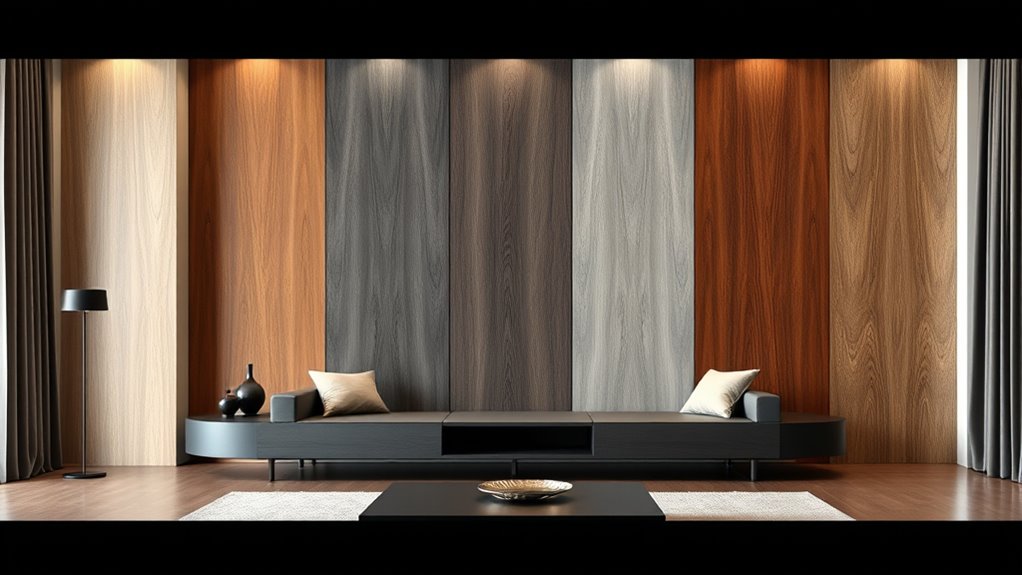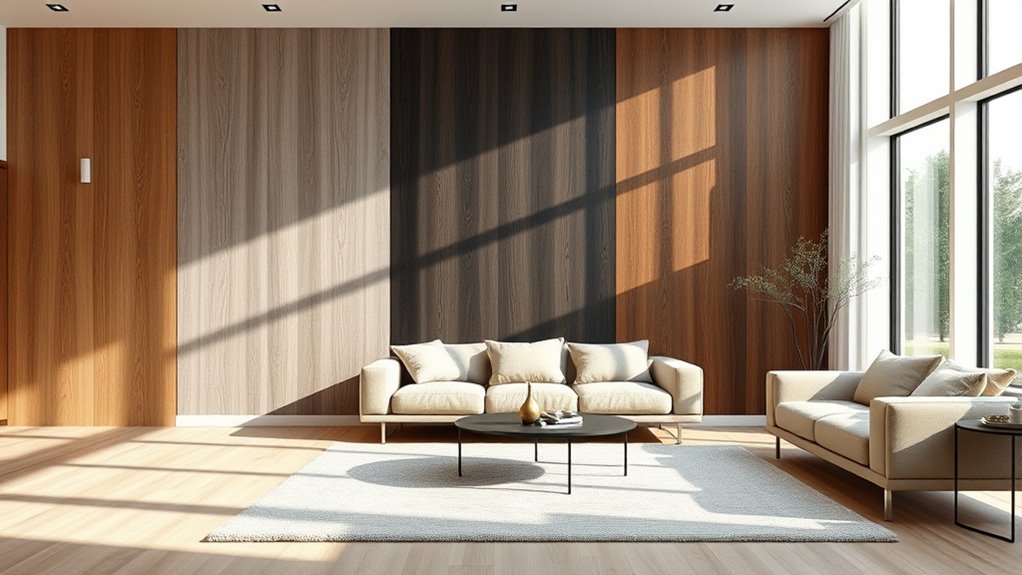Discover five designer-approved wood color palettes for modern homes that create warmth, balance, and style. Opt for light, airy tones like bamboo or ash-gray for a fresh, contemporary vibe. Warm woods such as cherry or reclaimed oak evoke comfort and richness, while cooler shades like gray-washed or walnut add sleek sophistication. Mixing these tones thoughtfully helps highlight architectural features and furniture. Continue exploring to uncover how these palettes can transform your space into a modern haven.
Key Takeaways
- Incorporate a mix of sustainable woods like bamboo, reclaimed oak, and walnut for eco-friendly and textured palettes.
- Combine warm and cool wood finishes, such as cherry with ash-gray, to create depth and modern sophistication.
- Use light woods like bamboo for bright, airy spaces, balanced with richer, darker tones for contrast.
- Layer different textures and finishes to add visual interest, highlighting architectural features and furniture.
- Focus on proportion and scale, pairing larger pieces with contrasting accents to achieve a harmonious, contemporary look.

Ever wonder how designers choose the perfect wood tones to create a cohesive and inviting space? The secret often lies in carefully selecting sustainable wood options and mastering the art of mixing wood finishes. Choosing sustainable woods not only benefits the environment but also provides a warm, authentic look that can be seamlessly integrated into modern homes. When mixing wood finishes, you create depth and visual interest, avoiding a flat or monotonous appearance. This approach allows you to layer different textures and shades, making your space feel layered and thoughtfully curated without overwhelming the senses. Incorporating home improvement principles like creating designated zones and utilizing multi-functional furniture can further enhance the overall design harmony. Start by considering lighter woods like bamboo, which is a highly sustainable choice. Its natural hue brings freshness and brightness, perfect for spaces that aim for a clean, airy feel. Pairing bamboo with slightly darker woods like reclaimed oak or walnut can create a striking contrast that remains harmonious. Mixing wood finishes is less about matching perfectly and more about balancing tones to achieve a natural flow. For example, if you have a warm-toned oak flooring, adding furniture with a cooler, ash-gray finish can create a modern yet cozy vibe. The key is to think about the undertones in each wood and how they complement or contrast with each other, resulting in an intentional and polished look. When selecting wood colors, keep in mind the atmosphere you want to evoke. Warm woods like cherry or maple add a sense of comfort and richness, perfect for creating inviting living spaces. On the other hand, cooler tones such as ash or gray-washed woods lend a sleek, contemporary feel. Incorporating sustainable options ensures you’re making eco-friendly choices while still achieving the aesthetic you desire. Look for FSC-certified options or reclaimed woods, which add character and history to your design. Balancing different wood tones and finishes involves paying attention to scale and proportion. Use larger pieces, like a dining table or a feature wall, to anchor your room, then layer in smaller accents with contrasting finishes. This technique prevents the space from feeling chaotic and ensures a cohesive look. When done intentionally, mixing wood finishes can also highlight different architectural features or furniture styles, making your home feel dynamic but unified. In the end, selecting a wood palette that combines sustainable options and skillful mixing of finishes allows your space to feel modern, warm, and uniquely yours. It’s about creating a story with textures and tones that resonate with your style, all while keeping environmental responsibility at the forefront.
Frequently Asked Questions
How Do I Choose the Right Wood Color for Small Spaces?
When choosing the right wood color for small spaces, consider your overall style and the mood you want to create. Explore different wood stain options that can brighten or warm the room. Use color coordination tips like pairing light woods with neutral walls to make the space feel larger. Opt for reflective surfaces and minimal decor to enhance the effect. Trust your instincts and choose a wood tone that complements your design vision.
Can These Palettes Be Adapted for Outdoor Furniture?
Did you know outdoor furniture can last longer with proper finishes? You can adapt these palettes by choosing seasonal color trends and eco-friendly finishes to withstand weather. Opt for durable, weather-resistant woods and finishes that embrace natural tones, ensuring your furniture remains stylish and sustainable. This way, you’ll enjoy the beauty of designer-inspired colors outdoors while staying eco-conscious and resilient against the elements.
What Are the Maintenance Requirements for Different Wood Finishes?
You should consider the wood stain types and finish durability for proper maintenance. For oil-based stains, you’ll need to reapply every couple of years, while water-based stains require less frequent touch-ups. To keep your wood looking its best, clean surfaces regularly with mild soap and water, and re-seal or re-varnish as needed. Proper maintenance guarantees your wood finish stays vibrant and durable over time.
How Do Wood Color Choices Impact Room Lighting?
Think of your room as a canvas—wood color choices act like the brushstrokes shaping the mood. Light-colored woods reflect sunlight, brightening the space and emphasizing wood grain textures, while darker hues absorb light, creating cozy contrast. Using color contrast techniques, you can balance natural light, making your room feel larger or more intimate. Your wood selection directly influences how the light dances, transforming your space into a tailored haven.
Are These Palettes Suitable for Traditional Home Styles?
You might wonder if these palettes suit traditional aesthetics. While they’re designed with modern homes in mind, some palettes can blend well with traditional styles if you choose warmer, richer wood tones that respect historical accuracy. Focus on classic finishes and timeless hues to guarantee your space feels authentic and cohesive. With careful selection, these palettes can complement your traditional home while adding a fresh, updated look.
Conclusion
Now that you’ve explored these designer-approved wood color palettes, it’s time to bring your modern home to life. Think of each shade as a brushstroke on a canvas, transforming your space into a harmonious masterpiece. Whether you choose warm, earthy tones or cool, sophisticated hues, these palettes will elevate your decor. Trust your instincts and let your style shine through—your perfect wood color palette is waiting to turn your house into a warm, inviting haven.









